How to Fix a Running Toilet Without a Ball Float
Author: Omar Alonso | Editor: Omar Alonso
Review & Research: Jen Worst & Chris Miller
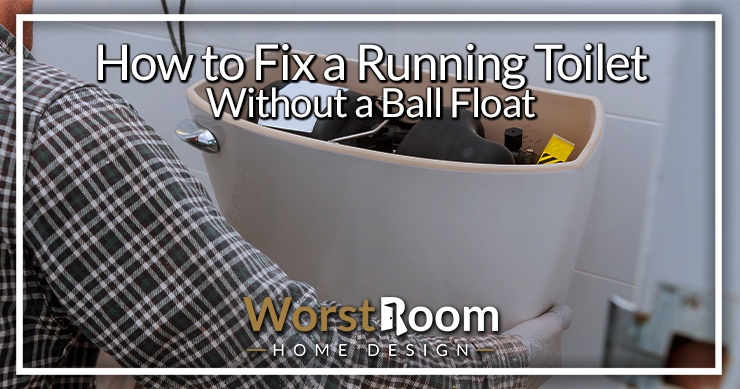
Are you tired of dealing with a running toilet and wondering if there's any way to fix it without having to buy and install some other system like a ball float? It may seem like a daunting task, we'll show you how to fix a running toilet without a ball float. It's fairly simple once you've been shown.
Let's explore how to repair your own toilet without needing specialized tools or materials - as well as what benefits come from doing so. We'll also discuss when it might be best for you to seek professional assistance in repairing your toilet instead. So don't despair. We'll get this fixed together.
Why Your Toilet Won’t Stop Running
A running toilet is a common occurrence, and it can be an irritating annoyance. It's important to understand what causes this issue so that you can diagnose and repair it. The causes are generally the same no matter the type of contraption inside the toilet tank.
A running toilet occurs when water continuously flows from the tank into the bowl after flushing, resulting in an annoying sound and higher water bills. This can happen to any types of toilets, including a toilet without a float ball.
This happens because either the flush valve isn't closing correctly, which allows water to continue flowing through the system even after flushing has stopped, or the fill valve isn't closing early enough to keep the water level in the tank low enough to not cause it to run down the overflow tube.
Causes of a Running Toilet
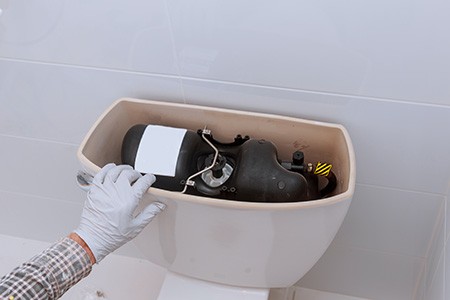
This problem has several potential causes, including:
- Worn-out or misaligned parts like gaskets, washers, seals, & valves
- Incorrect chain length or float height (very common)
- Corroded components (your toilet water may be brown)
- Clogged pipes (often your toilet water will rise and drain repeatedly)
- Insufficient supply pressure
Additionally, if your home uses older toilets with outdated designs, these may contribute to frequent running issues due to inadequate design features such as poor flapper seals or weak flush valves.
Once you have identified the problem, it is time to move on to repairing your running toilet. This requires shutting off the water supply and replacing or adjusting certain components of the toilet system. Before this is over you'll be familiar with all the parts inside a toilet tank by name.
How to Fix a Running Toilet Without a Ball Float in 4 Easy Steps
Here are three simple steps to fixing this running toilet issue. The first step can take as little as a few seconds. The second step is optional and you may not need it. It's the third and fourth steps that takes a little effort but they're not difficult either.
Shutting Off the Water Supply
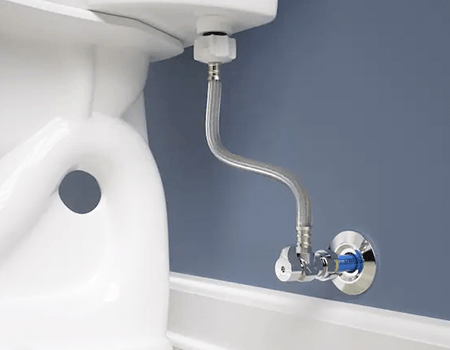
Before attempting DIY repairs, shutting off the water supply is essential. To do this, locate and turn the valve clockwise until you can no longer turn it. The valve should be near the toilet situated on a wall, with a tube linking it to the toilet.
Turning this off will stop water from entering your toilet bowl and prevent flooding. Remember, "righty tighty, lefty loosey", which means turning it clockwise will close the valve and counter-clockwise opens it back up.
Replacing the Flapper Valve (Optional)
The flapper valve is a key component in preventing a running toilet. If the flapper valve is worn or broken, it must be swapped out with a compatible one to bring back optimal performance. Some people do things like pour Fabuloso in their toilet tank and wonder why their flappers are corroded. Don't do this!
To replace the flapper valve, first remove any existing components, such as nuts and bolts, before carefully lifting out the old unit and replacing it with a new one of equal size and shape. Identify the types of toilet flapper valves in your house using our guide here.
You may not think to do so but pay attention when doing the disassembly so you can simply reverse the steps for the next installation. This way, you'll know where the required bolts go, how each piece is seated and sealed, and so forth.
Adjusting the Chain Length & Flapper Height
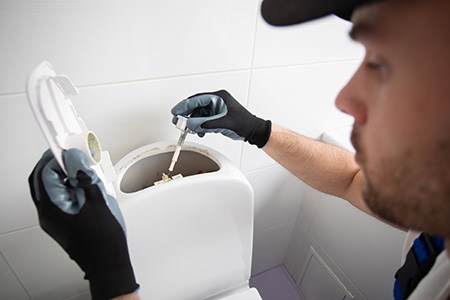
The chain length should also be adjusted if necessary so that when lifted by its handle, enough slack remains between its connection point on the flush lever arm and its attachment point on the flapper valve for proper operation of both parts. Without this slack, the flapper may not close, which can lead to a situation where your toilet won’t stop running.
Additionally, adjusting the flapper height may be required to ensure optimal performance. If your flapper allows, simply twist or rotate it counterclockwise to lower or clockwise to raise depending on what’s needed for your particular situation. This ensure it reseals at the proper water level so it doesn't keep the drain open endlessly.
Adjust the Toilet Fill Valve
This is your main focus when it comes to how to fix a running toilet without a ball float. When the flapper opens up and allows the tank to drain into the bowl, the toilet fill valve (sometimes called a "ballcock") will open up to begin refilling the tank with water once the water level reaches a certain lower water level and the flapper closes again.
Generally there is a ball float that sinks with the water level that opens the fill valve and as it rises with the water level, it shuts the fill valve off before the water level reaches the level of the overflow tube, which drains water into the bowl. When your toilet is running endlessly, it's because this water level is rising too high and draining into the overflow tube and into the bowl.
A toilet without a ball float will have a water level adjusting screw on the fill valve. This screw connects to the inlet valve and connects that to a filler float (the widest part of the fill valve mechanism). That float does what the ball float would have done. Even a toilet fill valve with no float ball still has a float, it's just built into the mechanism.
So by adjusting the screw, you can dictate when that float tells the valve to shut off and stop filling the toilet tank. In your case, the screw likely needs to be tightened so that the filler float moves downwards some. This way, as the water level rises, it tells the water inlet valve to shut off sooner (which is to say, at a lower water level so it doesn't flow water into the overflow tube).
Benefits of DIY Repairs
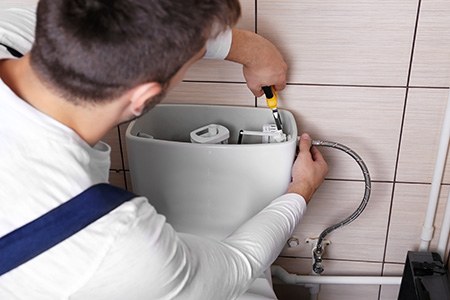
Do-it-yourself (DIY) repairs for a running toilet without a ball float can be an incredibly rewarding experience. The main benefit is the yield of monetary savings and beneficial knowledge acquisition. Once you know how to do this, you'll always be able to.
Major Cost Savings
Fixing a running toilet yourself can save money on labor costs and replacement parts. It also allows you to develop plumbing skills and gain knowledge about how the system works. With plumbing tools, replacing parts like flapper valves is incredibly inexpensive compared to professional services.
DIY repairs can be invaluable in understanding how different components work together, and you can save time and money on future plumbing issues by being able to handle them yourself. Fixing a running toilet without a ball float is an easy task with the right tools and replacement parts.
Tools Needed for DIY Repairs
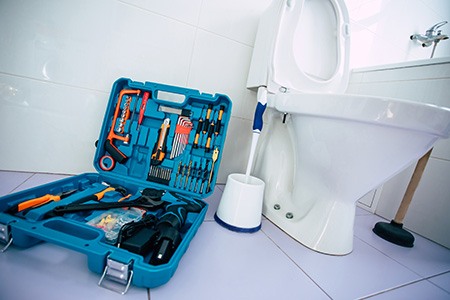
The right tools and replacement parts are crucial before executing a plan on how to fix a running toilet without a ball float. Adjustable wrenches, screwdrivers, and pliers are essential tools for loosening and tightening nuts, bolts, and screws. You probably already have those around.
Flapper valves and fill valve assemblies are important replacement parts that must match your current model size and type. Flapper valves act as a seal between the water supply line and the bowl when flushed and should be replaced immediately if worn out or cracked.
Fill valve assemblies control the amount of water that enters the tank after each flush cycle, and replacing them may be necessary if they are not working correctly. However, it is essential to recognize when to seek professional help and only attempt DIY repairs if you are confident in your ability to complete the job.
After turning off the water to the toilet and removing these parts (if they need to be replaced) simply take the parts with you to the hardware store and let an associate at the store help you find the correct replacement parts.
Professional Help is Available
Calling a professional plumber can be a wise decision when facing a difficult plumbing job, especially if you are unfamiliar with the repair needed. Ongoing issues or failed DIY attempts may indicate underlying problems that require expert attention. A certified technician possesses knowledge of local codes and manufacturer guidelines and can offer warranties on their services.
By having a pro handle the job, you can be confident that everything was installed correctly and no future issues will arise due to shoddy workmanship or subpar materials used during DIY repairs. In other words, hiring a pro is like having an ace up your sleeve.
Do All Toilets Have a Float Ball?
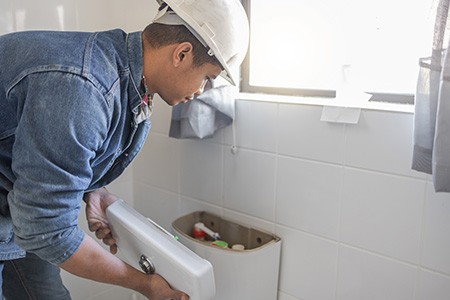
No, not all toilets have a float ball. A float ball is typically found in older-style toilets with a gravity flush system. More modern designs regulate the water level by a fill valve and flapper assembly instead of a separate floating mechanism with a ball float. Some newer models also feature dual-flush systems, which allow for two different levels of water to be used depending on what type of waste needs to be flushed away.
Summary: Fixing a Running Toilet Without a Float Ball
First, turn off the water supply to the toilet. Then, inspect the fill valve and flush valve for any damage or debris causing it to malfunction. Adjust the float on the fill valve and the chain running to the flapper so that it ceases running when sufficient water is in the tank.
Additionally, check for any blockages in the overflow pipe or other parts of the toilet's plumbing system that could prevent proper drainage. Finally, test your repairs by turning on the water supply and flushing again; if all goes well, you should have a functioning toilet with no running water.
That’s How to Fix a Running Toilet Without a Ball Float
Repairing a running toilet with or a toilet without a ball float can be an intimidating task until you become acquainted with what you're looking at. With the correct tools and understanding of how to do it safely, you can significantly save time and money by attempting this repair yourself.
While professional assistance is always available if needed, taking on DIY repairs will help you gain confidence in your abilities while saving money in the long run. So don't let fear stop you from learning how to fix a running toilet without a ball float - get started today using our guide above if your toilet won’t stop running.



